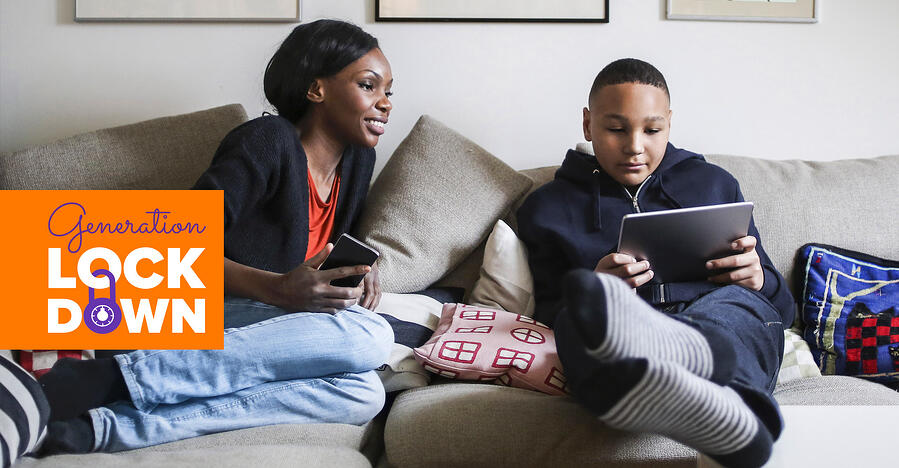
Plus, how to make online safety part of the daily conversations you have with them
Talking about online safety with your kids is… awkward. Not unlike the other talk that parents avoid, the online safety conversation can feel overwhelming, intimidating, and even embarrassing. Maybe you’re worried they know more than you do. Maybe you’re not even sure what dangers kids today face online today. Or maybe you’re scared that they’ve already done something that put them in danger. But whatever the reason you might be avoiding The Talk (Online Version), it can’t be avoided forever. And, awesomely, more parents are having these conversations since the Covid-19 pandemic started. According to the Avast Kids Online: Generation Lockdown survey, 47 percent of parents are having more of these conversations since going into lockdown and spending more time online. In the interest of getting that number closer to 100 percent, we spoke with psychotherapist and author Catherine Knibbs — who works with clients who have experienced trauma online — and kids’ online safety expert Parven Kaur, the founder of Kids N Clicks, which helps families navigate and thrive in the digital world. Here’s what they told us. First things first: Kaur says the conversation about online safety will never be a one-and-done situation. Like other tricky conversations, parents should be prepared to have conversations about online safety over and over again. In fact, Kaur suggests making it a part of the daily conversation you have with your kids. “For example, we tend to ask children about how school was and what they learned,” Kaur previously told Avast. “The same way we need to regularly ask our children if they have seen or read anything interesting online. Ask them if they have seen any funny viral video, they can share with you. Ask them if they saw something that upset them. The point of these questions is to show your child that you are interested in their digital world.” Knibbs adds that it’s a good idea to have these conversations when there’s “a little bit of distraction.” She suggests bringing up the conversation while you’re going on a walk, in the car, or just finished eating. Lead with compassionate curiosity, starting the conversation by saying something like “I’m just wondering…” “Try something like, ‘I’m just wondering… how would you know if someone was trying to steal your data?’” Knibbs suggests. “Try making it about cybersecurity rather than cyber safety, depending on the age of your kid.” She also suggests modeling it as a situation that happened to you that you need advice for. “Kids love giving advice to the ‘experts,’” Knibbs says. “Young people love to help out those who are slightly older.” The specifics of what to include in your online conversations with your kids are going to depend on their age, maturity level, and your own knowledge of what they need. “The conversations we have with them will also differ according to their age group and maturity,” Kaur says. “For younger children, we can introduce to them the idea of how the internet actually works. For example, get them to think about the internet as a global city where everyone is far away but can be connected to each other. Get them to think about how there is always a person sitting behind a screen and what we say or do might affect that person.” Regardless of their age, your kid will very likely not want to have this conversation with you. Knibbs points out that, up until about age 12, kids actually can’t understand long term consequences. In fact, that’s something that’s often difficult for full-grown adults to do. “Young people go, ‘Ugh! I’m fine!’” Knibbs says. “Because they don’t actually understand risk. It’s a bit like the Covid-19 virus. For some people it’s like, ‘I can’t see the virus, therefore I don’t see the dangers,’ right?” Another place parents might see resistance is if they present the issue as, “If you do this, bad things will happen.” In addition to the fact that kids can’t see long term consequences, it’s pretty well known that telling many kids “don’t do this” is going to result in them wanting to do it. Instead, Knibbs suggests having conversations in a more roundabout way. “Rather than saying ‘there are bad people out there online,’” Knibbs says. “Say something like, ‘Who are friends online? How do you know they’re a friend and not just someone you talk to? How do you know it’s a genuine person?’” Questions like these help kids develop the critical thinking skills they need to navigate both the digital and physical world. Knibbs says they’re especially important when dealing with online grooming, as they’re the skills that will help your kid realize, “Hmmm, something about this isn’t right.” But Knibbs also cautions against focusing solely on the “big monsters” of online child predators, to the detriment of talking about other issues that might come up online. Cyberbullying, for example, is a huge for kids online today and Knibbs sees many clients who are seriously traumatized by the things “friends” have said about or to them online. And, finally, Knibbs wants all parents to know that, no matter your level of tech literacy, you’ve got this. “I used to say if you’re not tech savvy, get tech savvy,” Knibbs says. “But it’s a certain type of personality who wants to be tech savvy. Instead, become the expert of your child. And most people are the expert of their child.”When to have the online safety talk (or talks)
What to include in your online safety talks
如有侵权请联系:admin#unsafe.sh
.png)